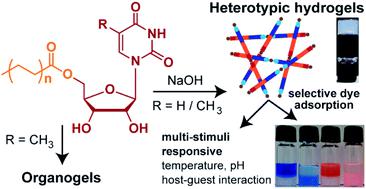当前位置:
X-MOL 学术
›
Nanoscale Adv.
›
论文详情
Our official English website, www.x-mol.net, welcomes your
feedback! (Note: you will need to create a separate account there.)
Multi-stimuli responsive heterotypic hydrogels based on nucleolipids show selective dye adsorption
Nanoscale Advances ( IF 4.6 ) Pub Date : 2020-07-13 , DOI: 10.1039/d0na00509f Ashok Nuthanakanti 1 , Seergazhi G Srivatsan 1
Nanoscale Advances ( IF 4.6 ) Pub Date : 2020-07-13 , DOI: 10.1039/d0na00509f Ashok Nuthanakanti 1 , Seergazhi G Srivatsan 1
Affiliation

|
Analogous to nucleic acids, the building blocks of nucleic acids and their derivatives are widely used to create supramolecular architectures for application mainly in the field of biomedicine. Here, we describe the construction of a multi-stimuli responsive and toxic dye adsorbing heterotypic hydrogel system formed using simple nucleoside–fatty acid conjugates. The nucleolipids are derived by coupling fatty acid chains of different lengths at the 5′ position of ribothymidine and uridine. The nucleolipids in the presence of a strong base (e.g. NaOH) undergo partial hydrolysis, which triggers the self-assembly of the hydrolysed components resulting in the formation of heterotypic hydrogels. Notably, the gels are formed specifically in the presence of Na+ ions as other ions such as Li+ and K+ did not support the hydrogelation process. Systematic analysis by microscopy, NMR, single crystal and powder X-ray diffraction and rheology indicated that the deprotonated nucleolipid and fatty acid salt interdigitate and provide necessary electrostatic interactions supported by Na+ ions to set the path for the hierarchical assembly process. Notably, the hydrogels are highly sensitive to external stimuli, wherein gel–sol transition can be reversibly controlled by using temperature, pH and host–guest interaction. One of the hydrogels made of 5′-O-myristate-conjugated ribothymidine was found to selectively adsorb cationic dyes such as methylene blue and rhodamine 6G in a recyclable fashion. Taken together, the easily scalable assembly, multi-stimuli responsiveness and ability to capture and release dyes highlight the potential of our nucleolipid hydrogel system in material applications and in the treatment of dye industry wastes.
中文翻译:

基于核脂的多刺激响应异型水凝胶表现出选择性染料吸附
与核酸类似,核酸及其衍生物的构建模块被广泛用于创建超分子结构,主要应用于生物医学领域。在这里,我们描述了使用简单的核苷-脂肪酸缀合物形成的多刺激响应和有毒染料吸附异型水凝胶系统的构建。核脂是通过在核糖胸苷和尿苷的5'位置偶联不同长度的脂肪酸链而衍生的。核脂在强碱(例如NaOH)存在下会发生部分水解,从而引发水解组分的自组装,从而形成异型水凝胶。值得注意的是,凝胶是在 Na +离子存在下特异性形成的,因为其他离子(例如 Li +和 K +)不支持水凝胶化过程。通过显微镜、核磁共振、单晶和粉末 X 射线衍射和流变学进行的系统分析表明,去质子化的核脂和脂肪酸盐相互交错,并提供由 Na +离子支持的必要静电相互作用,为分级组装过程设定路径。值得注意的是,水凝胶对外部刺激高度敏感,其中凝胶-溶胶转变可以通过温度、pH 值和主客体相互作用进行可逆控制。一种由 5'- O-肉豆蔻酸酯缀合的核糖胸苷制成的水凝胶被发现能够以可回收的方式选择性吸附阳离子染料,例如亚甲基蓝和罗丹明 6G。 总而言之,易于扩展的组装、多刺激响应性以及捕获和释放染料的能力凸显了我们的核脂水凝胶系统在材料应用和染料工业废物处理中的潜力。
更新日期:2020-09-16
中文翻译:

基于核脂的多刺激响应异型水凝胶表现出选择性染料吸附
与核酸类似,核酸及其衍生物的构建模块被广泛用于创建超分子结构,主要应用于生物医学领域。在这里,我们描述了使用简单的核苷-脂肪酸缀合物形成的多刺激响应和有毒染料吸附异型水凝胶系统的构建。核脂是通过在核糖胸苷和尿苷的5'位置偶联不同长度的脂肪酸链而衍生的。核脂在强碱(例如NaOH)存在下会发生部分水解,从而引发水解组分的自组装,从而形成异型水凝胶。值得注意的是,凝胶是在 Na +离子存在下特异性形成的,因为其他离子(例如 Li +和 K +)不支持水凝胶化过程。通过显微镜、核磁共振、单晶和粉末 X 射线衍射和流变学进行的系统分析表明,去质子化的核脂和脂肪酸盐相互交错,并提供由 Na +离子支持的必要静电相互作用,为分级组装过程设定路径。值得注意的是,水凝胶对外部刺激高度敏感,其中凝胶-溶胶转变可以通过温度、pH 值和主客体相互作用进行可逆控制。一种由 5'- O-肉豆蔻酸酯缀合的核糖胸苷制成的水凝胶被发现能够以可回收的方式选择性吸附阳离子染料,例如亚甲基蓝和罗丹明 6G。 总而言之,易于扩展的组装、多刺激响应性以及捕获和释放染料的能力凸显了我们的核脂水凝胶系统在材料应用和染料工业废物处理中的潜力。











































 京公网安备 11010802027423号
京公网安备 11010802027423号